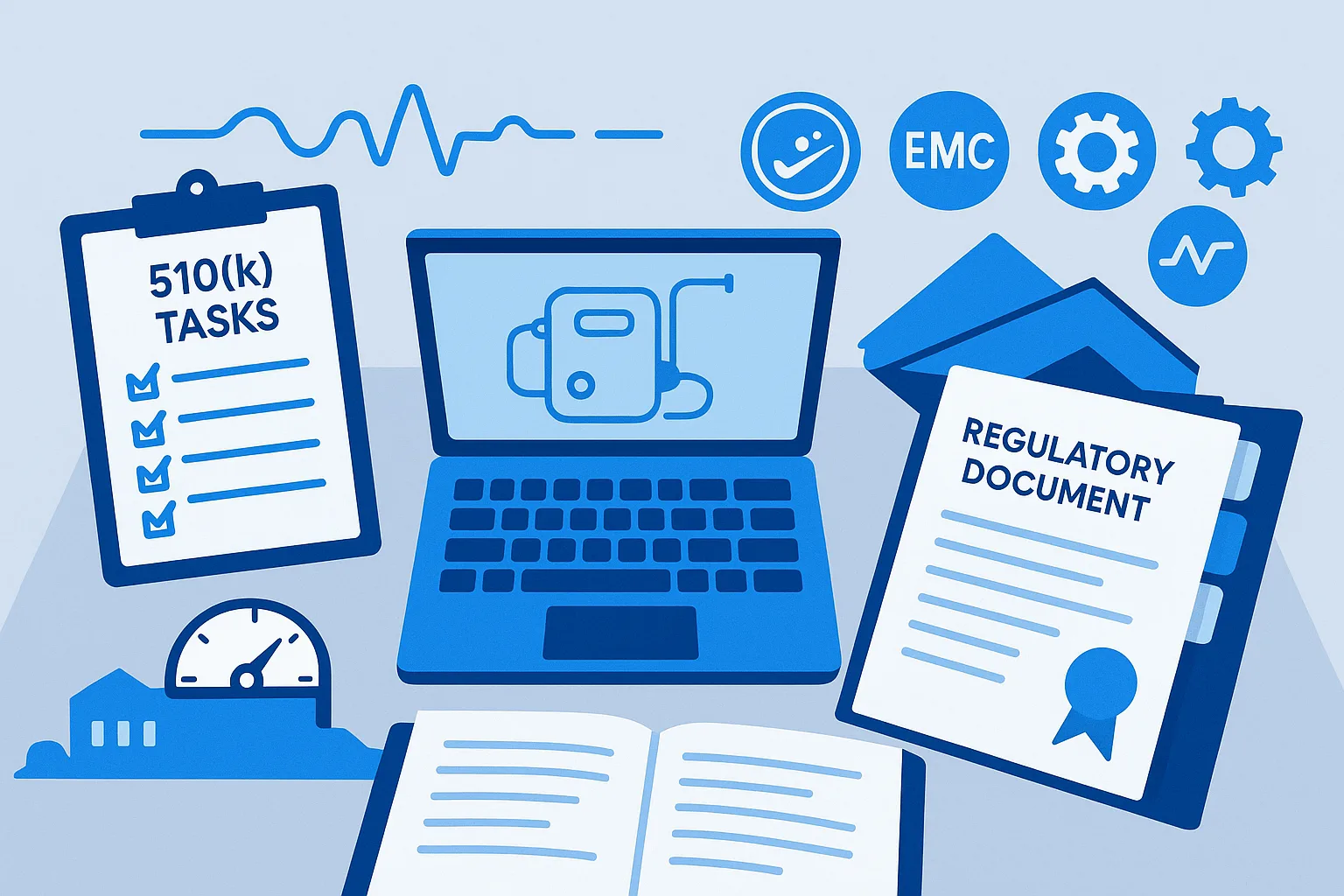First-time founder’s playbook to plan, build, and submit a Class II 510(k). Timelines, testing, documents, and common pitfalls—explained for startups in 2025.
Medical device 510(k) consulting for first-time startup founders in 2025. This step-by-step guide breaks down how to plan your evidence, pick a predicate, avoid rework, and ship a compliant submission on time.
- What you’ll learn
- Who this playbook is for
- Step 1 — Confirm pathway & product code
- Step 2 — Choose a credible predicate & craft Intended Use
- Step 3 — Map your evidence plan (testing matrix)
- Step 4 — Build the 510(k) the way reviewers read it
- Step 5 — Plan timeline & budget like a startup
- Step 6 — Avoid common 510(k) pitfalls
- Printable startup 510(k) checklist
- FAQs
What you’ll learn
- How to confirm your device’s classification and pathway
- Exactly what testing and documents 510(k) reviewers expect in 2025
- A realistic startup timeline and budget bands
- Common pitfalls—and how consulting prevents them
Who this 510(k) playbook is for
This guide is for first-time medical device startup founders, product leaders, and regulatory leads building a Class II device that will go through the U.S. FDA’s 510(k) premarket notification process. If you’re working on a connected device, digital health accessory, diagnostic accessory, or benchtop instrument, you’re in the right place.
Step 1 — Confirm your pathway and product code
- Identify your regulation number, product code, and classification.
- Cross-check recent clearances to validate Traditional vs. Special/Abbreviated 510(k).
- Pressure-test edge cases (novel materials, software claims, wireless) that could add expectations.
Step 2 — Choose a credible predicate & craft your Intended Use
- Your Intended Use sets the scope for performance data.
- Prefer a predicate cleared in the last 3–7 years with matching technology, indications, and environment of use.
- If you differ in a meaningful way, plan objective evidence to show no new questions of safety or effectiveness.
Step 3 — Map your evidence plan (testing matrix)
Tie risks and claims to required evidence:
- Bench performance (verification against design inputs)
- Electrical safety and EMC (appropriate IEC/ISO standards)
- Biocompatibility (contact type and duration; ISO 10993 framework)
- Sterilization and packaging (if sterile), shelf life and transport
- Software and cybersecurity (lifecycle docs + risk-based threat mitigations)
- Usability/Human Factors (formative and, when warranted, summative validation)
- Clinical data (only if non-clinical evidence can’t address key questions)
Step 4 — Build the 510(k) the way reviewers read it
- Cover letter, 510(k) summary, truthfulness/accuracy statements
- Device description (features, operation principles, drawings/photos)
- Intended Use / Indications for Use
- Substantial Equivalence (predicate, similarities/differences, evidence)
- Standards declarations and test reports (with explicit pass/fail)
- Risk management summary (hazards → mitigations → tests)
- Labeling and IFU (consistent with Intended Use and mitigations)
- Software & cybersecurity documentation (level-appropriate)
- Biocompatibility, sterilization, shelf life, packaging, transport (as applicable)
- Human factors/usability data (when needed)
Step 5 — Plan your timeline and budget like a startup
Typical phases and durations:
- Pathway & predicate strategy: 2–4 weeks
- Protocols & test readiness (evidence plan, fixtures, vendors): 3–6 weeks
- Verification & supporting studies (bench, EMC/electrical, packaging/sterility, software docs): 6–14+ weeks
- Submission assembly (admin, summaries, labeling, SE comparison): 3–5 weeks
- FDA review: ~90 days statutory; expect at least one AI round if questions arise
Budget bands:
- Evidence planning & consulting: low five figures
- Testing: varies widely by standard and vendor
- Assembly: low–mid five figures
Step 6 — Avoid common 510(k) pitfalls
- Vague Intended Use → moving targets and added testing
- Unaligned labeling → marketing/claims must match submission
- Protocols written after testing → undermines credibility
- Missing worst-case selection → inadequate stress on performance
- Software gaps → thin lifecycle docs or weak cybersecurity rationales trigger AI
- Underestimating usability → high-risk tasks often warrant summative validation
How consulting accelerates first-time 510(k) teams
A seasoned medical device consulting partner helps first-time founders reduce cost and risk by front-loading the right decisions:
- Predicate selection and Intended Use wording that avoid new safety/effectiveness questions
- Right-sized test plans and vendor selection (no gold-plating, no shortcuts)
- Submission formatting aligned to reviewer expectations to minimize AI cycles
Startup 510(k) checklist (printable)
- ✅ Regulatory Position (regulation, product code, classification)
- ✅ Predicate(s) and Intended Use statement
- ✅ Risk analysis aligned with claims and use
- ✅ Test protocols with acceptance criteria and worst-case selection
- ✅ Completed bench/EMC/biocomp/usability/packaging/sterility (as applicable)
- ✅ Labeling and IFU consistent with Intended Use
- ✅ Substantial Equivalence comparison table
- ✅ Admin documents (510(k) summary, statements, certifications)
FAQs: first-time 510(k) for medical device startups
Do we always need clinical data?
How long does FDA review take?
What if our technology differs from the predicate?
Keywords: medical device consulting, 510(k) submission consulting, first-time medical device startup, Class II device, predicate selection, evidence plan, usability testing, cybersecurity documentation, EMC testing, FDA 510(k) playbook 2025
